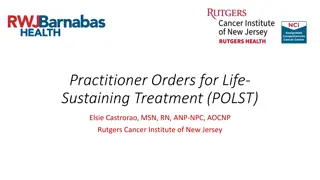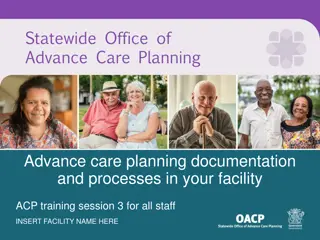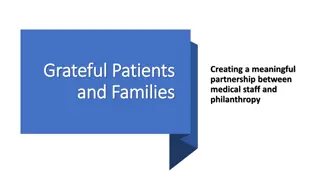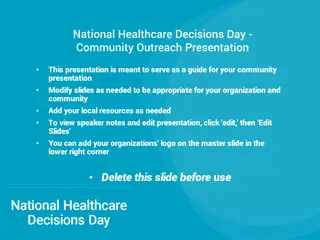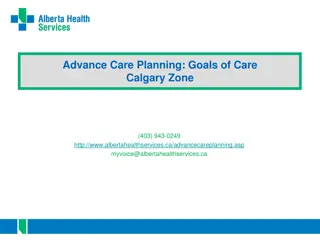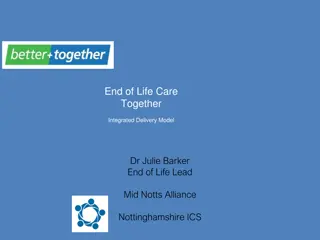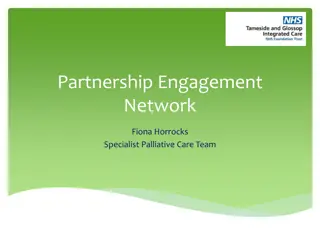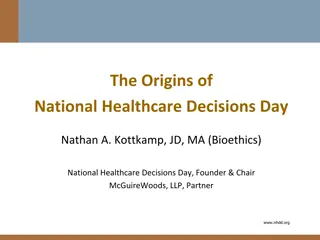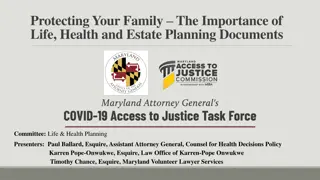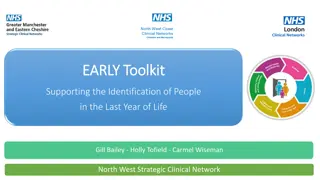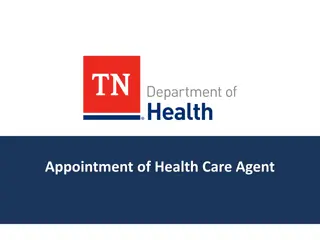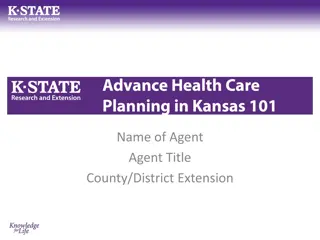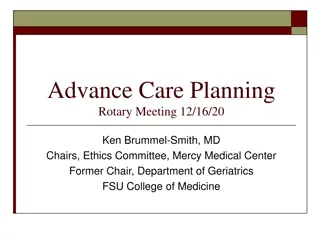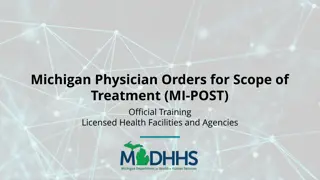Understanding Advance Care Planning and Goals of Care in Healthcare
This informative content discusses Advance Care Planning (ACP) and Goals of Care (GOC) in healthcare, including the importance of these conversations, representation agreements, temporary substitute decision makers, and the difference between ACP and GOC. It also touches on CPR and end-of-life care decisions, providing valuable insights for healthcare professionals and individuals navigating healthcare choices.
Download Presentation

Please find below an Image/Link to download the presentation.
The content on the website is provided AS IS for your information and personal use only. It may not be sold, licensed, or shared on other websites without obtaining consent from the author. Download presentation by click this link. If you encounter any issues during the download, it is possible that the publisher has removed the file from their server.
E N D
Presentation Transcript
ACP/Goals of care Dr Wendy Yeomans Medical Director Palliative Care Program Vancouver General Hospital
Objectives To define Advance Care Planning (ACP) and Goals of Care (GOC) To clarify DNR/CPR/MOST To get some tools in your tool box for opening discussions with patients and families
Advance Care Planning (ACP) - Helps patients establish decisions about future care should they lose capacity. - Discussions are centered around beliefs, goals and values, rather than specific outcomes and interventions. - Is voluntary, can be oral, best if written (My Voice). - Conversations done around the kitchen table.
Representation agreement Officially appoints representative if someone loses decision making capacity (SDM). Section 7 - routine management of financial, personal care and some health care. Not decisions about life support, facility placement. Section 9 - purely health care. Must follow advance directive. No financial involvement. Enduring Power of Attorney.
Temporary Substitute Decision Maker If there is no ACP or Section 9 rep agreement, who do health care providers go to? The order matters, but goes to the first available person. The adult s spouse The adult s child (may be any child; birth order not relevant) The adult s parent The adult s brother or sister (any sibling; birth order not relevant) The adult s grandparent The adult s grandchild (any grandchild; birth order not relevant) Anyone else related by birth or adoption to the adult A close friend of the adult A person immediately related to the adult by marriage
Advance Care Plan versus Goals of Care what is the difference? ACP is a plan for the future This is what I think I want -- plan for making personal and health care decisions in the event that a person become unable to do so him/herself in the future **It is not the GOC conversation** GOC/MOST decisions and care plan based on the current situation (this is where the rubber hits the road) -- dynamic, changing and concrete
CPR Has become associated with the ultimate in doing everything, and providing the best care. Is the expected standard of care offered to everyone unless indicated otherwise. No CPR is essentially Allow a Natural Death .
Cardiopulmonary resuscitation CPR is traditionally thought of as chest compressions/defibrillation and intubation for ventilatory support. DNACPR= Do Not Attempt CPR. DNR . There are now more subtle forms of resuscitation such as BiPAP, vasopressors. Resuscitation needs to be clearly defined.
Who can be resuscitated with traditional CPR? Healthy patients who have an acute medical event. Some instances of chronic illness show 40% survive and 13% go on to discharge.
Who is it not for? Patients dying of a chronic life limiting illness. e.g. metastatic cancer, multiorgan failure Chance of survival is near 0% with never leaving hospital.
No CPR Medical Orders for Scope of Treatment = levels of intervention= goals of care (GOC) Option 1: Supportive care, symptom management, comfort care. Allow natural death. Option 2: Therapeutic interventions to manage acute conditions outside a hospital eg po antibiotics within the limits of the residential care facility & program to which they are admitted. Option 3: Admission to an acute care hospital for medical/surgical treatment as indicated. No referral to critical care. Option 4: Maximum therapeutic effort including referral to critical care but no intubation and ventilation. Option 5: Maximum therapeutic effort including referral to critical care AND intubation and ventilation.
Challenges to changing the levels of intervention/GOC From the patient s point of view Patients are generally aware or the seriousness of their illness and state their preference to forgo life support if prognosis and QOL is poor. Patients are willing to discuss end of life issues but they are often waiting for staff to begin discussions. Patients look to us for guidance. Caregivers are often inaccurate about patient s QOL.
Challenges to changing the levels of intervention/GOC From the public Availability of treatments and investigations. Notion of doing something . Belief that the option to do nothing will lead to more discomfort. Religious and cultural beliefs. Lack of knowledge about the dying process.
Challenges to changing the levels of intervention/GOC From the health care team Unrealistic expectations of success. Lack of awareness of options when cure no longer possible. Difficulty withdrawing/withholding care. Lack of experience/discomfort in breaking bad news. Lack of previous trusting relationship. Time/lack of privacy/ interruptions. Personal & professional experiences with illness & death. Difficult prognostication.
Maintaining hope If they lose hope they will give up and stop fighting . A reminder that most people who are seriously ill are aware, and need to know the truth if they ask. If they are not told the truth and continue to fail , the message becomes they are not strong enough, which can lead to demoralization. It s the disease that is killing them, not the fact that they aren t strong enough to fight. Change the fight to fighting for peace and comfort.
Hope continued Hope can be maintained, but the nature of that hope changes. We can hope for things to improve but we need a back up plan. Prepare for the worst and hope for the best . We wish things were different . Make sure the family are present in these discussions and know you will establish how much the patient knows and only give as much information as the patient is willing to receive or ask for. At the very least the patient needs to know they will be well cared for if their condition deteriorates.
What not to say If you have a heart attack or stroke, we won t try to revive you. Do you want us to do everything possible? Would you agree to discontinue care? It's time we talk about pulling back. We ll make it so he won't suffer. I think we should stop aggressive therapy.
Goals of Care How to talk End-of-Life Care with a dying patient - Atul Gawande Video: http://www.youtube.com/watch?v=45b2QZxDd_o&NR=1 18
Four Questions from the video: Does the person know his prognosis? What is your understanding of your illness? How much do you want to know now? Would you prefer we speak to someone else? What are the person s greatest fears about what is to come? What are you most afraid of? What are the person s goals? What are you hoping for? What are the tradeoffs that the person is willing to make for the possibility of more time? What is most important to you?
Summary It s not about the DNR. It s a process not an epiphany.
Goals of care discussion principles The focus of the discussion is all about appropriate goals of care, not the DNR To focus on what we WILL do To support a good quality of life To insure a comfortable death when the time comes To educate patients and families to relieve fears If necessary, to inform patients and families of the legalities/ethics of the system (futility, do no harm)
Open ended questions Can you tell me about your illness? How is treatment going for you and for your family? What has been the most difficult for you and your family? Can you tell me more about what information you need? In the ED what do you hope I can do for you today
Positive Statements We will focus our efforts on treating your symptoms. We will concentrate on improving your quality of life. You will get the best care possible until the day you die. We will help you live meaningfully in the time you have left. Our focus will be your comfort and dignity. We want to ensure that your father receives the kind of treatment he wants. We can talk about what we need to do to achieve that.
Competent but fragile patient Assure comfort at all costs whatever happens Ask permission to include the SDM Indicate there needs to be a discussion regarding their care
Substitute decision maker (SDM) The SDM makes decisions based on what they believe are the patient's wishes. What would your father be thinking ? What would be important to your father ? What would he do in this circumstance ? Based on your father s condition, we are recommending X .how does this fit with your understanding of what your father would want in this situation ?
References http://www.ncbi.nlm.nih.gov/pmc/articles/P MC1291327/ Goals of care at the end of life. Marvin J Stone



